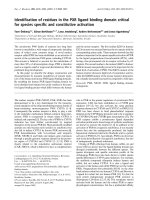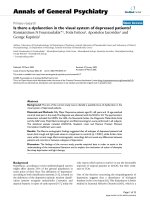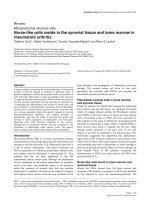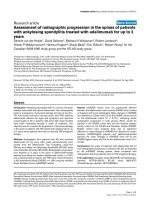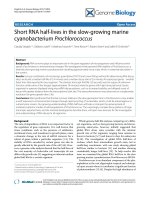Báo cáo y học: "Clinical review: Noninvasive ventilation in the clinical setting – experience from the past 10 year" pps
Bạn đang xem bản rút gọn của tài liệu. Xem và tải ngay bản đầy đủ của tài liệu tại đây (240.89 KB, 6 trang )
98
ARF = acute respiratory failure; CAP = community acquired pneumonia; CI = confidence interval; COPD = chronic obstructive pulmonary disease;
CPAP = continuous positive airway pressure; CPE = cardiopulmonary edema; ETI = endotracheal intubation; FiO
2
= fractional inspired oxygen; ICU =
intensive care unit; NIV = noninvasive ventilation; NPPV = noninvasive positive pressure ventilation; PaCO
2
= arterial carbon dioxide tension; PaO
2
=
arterial oxygen tension.
Critical Care February 2005 Vol 9 No 1 Antonelli et al.
Introduction
The term ‘acute respiratory failure’ (ARF) indicates a severe
deterioration in gas exchange, often requiring mechanical
ventilatory support with endotracheal intubation (ETI).
Placement of an endotracheal tube is associated with
increased risk for complications such as tracheal stenosis
[1,2] and ventilation associated pneumonia [3]. Noninvasive
ventilation (NIV; i.e. delivery of assisted breaths without an
invasive artificial airway) is a safe and effective tool in
correcting the pathophysiological mechanisms of ARF, and
reduces the work of breathing while concomitant treatments
correct the causes of the ARF. NIV has been used primarily in
patients with acute hypercapnic ventilatory failure, and
especially for acute exacerbation of chronic obstructive
pulmonary disease (COPD; Table 1).
Hypercapnic respiratory failure
The efficacy of NIV in treating acute exacerbations of COPD
was investigated by Brochard and colleagues [4] in a
European, randomized, multicenter study conducted in 85
COPD patients assigned to receive conventional treatment
(oxygen therapy plus drugs) or NIV. The group of patients
treated with NIV had fewer intubations (26% versus 74%;
P < 0.001), fewer complications (14% versus 45%;
P < 0.01), shorter length of hospital stay (23 ± 17 days
versus 35 ± 33 days; P < 0.02), and lower mortality (9%
versus 29%; P < 0.02).
In a recent meta analysis, Keenan and coworkers [5] reported
that the addition of noninvasive positive pressure ventilation
(NPPV) to standard care in patients with acute exacerbations
Review
Clinical review: Noninvasive ventilation in the clinical setting –
experience from the past 10 years
Massimo Antonelli
1
, Mariano Alberto Pennisi
2
and Luca Montini
3
1
Professor of Intensive Care and Anesthesiology, Unità Operativa di Rianimazione e Terapia Intensiva, Istituto di Anestesia e Rianimazione, Policlinico
Universitario A Gemelli, Università Cattolica del Sacro Cuore, Roma, Italy
2
Assistant Professor of Intensive Care and Anesthesiology, Unità Operativa di Rianimazione e Terapia Intensiva, Istituto di Anestesia e Rianimazione,
Policlinico Universitario A Gemelli, Università Cattolica del Sacro Cuore, Roma, Italy
3
Research Fellow, Unità Operativa di Rianimazione e Terapia Intensiva, Istituto di Anestesia e Rianimazione, Policlinico Universitario A Gemelli,
Università Cattolica del Sacro Cuore, Roma, Italy
Corresponding author: Massimo Antonelli,
Published online: 25 August 2004 Critical Care 2005, 9:98-103 (DOI 10.1186/cc2933)
This article is online at />© 2004 BioMed Central Ltd
Abstract
This brief review analyses the progress of noninvasive ventilation (NIV) over the last decade. NIV has
gained the dignity of first line intervention for acute exacerbation of chronic obstructive pulmonary
disease, assuring reduction of the intubation rate, rate of infection and mortality. Despite positive
results, NIV still remains controversial as a treatment for acute hypoxemic respiratory failure, largely due
to the different pathophysiology of hypoxemia. The infection rate reduction effect achieved by NIV
application is crucial for immunocompromised patients for whom the endotracheal intubation
represents a high risk. Improvements in skills acquired with experience over time progressively allowed
successful treatment of more severe patients.
Keywords COPD, helmet, hypoxemic respiratory failure, immunocompromised, noninvasive ventilation
99
Available online />of COPD decreased the rate of ETI (28% risk reduction,
95% confidence interval [CI] 15–40%), length of hospital
stay (4.57 days, 95% CI 2.30–6.83 days), and in-hospital
mortality rate (10% risk reduction, 95% CI 5–15%).
Subgroup analysis showed that these beneficial effects
occurred in those patients who were more severely ill, and
not in those with milder exacerbations. That meta-analysis
also included studies conducted in patients who had milder
exacerbations of COPD. In these investigations the mean
arterial pH of the study populations was close to normal and
the benefit from NIV was limited. In these studies the
enrolment of patients with only slightly compromised
respiratory function may account for the absence of relevant
physiological effects of NIV. A point that the meta-analysis did
not elucidate is whether patients with severe hypercapnia or
acidemia at hospital admission are less likely to respond to
NIV, as was reported in previous studies [6,7].
A recent Cochrane systematic review and meta-analysis [8]
evaluated randomized controlled trials that compared NPPV
with usual medical care in COPD patients with ARF. It found
that NPPV is associated with lower mortality (relative risk
0.41, 95% CI 0.26–0.64), decreased rate of ETI (relative risk
0.42, 95% CI 0.31–0.59), and greater improvements in
arterial carbon dioxide tension (Pa
CO
2
) and respiratory rate
after 1 hour of treatment. Also, there were fewer
complications with NPPV (relative risk 0.32, 95% CI
0.18–0.56).
Success rates with NIV improve with increasing physician
experience. Carlucci and coworkers [9] reported an 8-year
retrospective study in which they investigated the changes in
clinical practice of NIV in COPD patients. In that survey the
failure rate with NIV was constant over time, regardless of the
increasing severity of illness over the years. Between 1992
and 1996 the risk for NIV failure in more severely ill patients
(pH < 7.25 at admission) was threefold higher than during the
period 1997–1999. The authors concluded that
improvements in skills acquired with experience over time
progressively allowed successful treatment of patients who
are more severely ill.
NIV works not only in more experienced academic centers
but also in the real, clinical world. In a multicenter trial of the
use of NIV in general respiratory wards, Plant and colleagues
[10] randomly assigned 236 patients suffering from COPD
exacerbations to standard medical therapy alone or medical
therapy combined with NIV. Intubation and mortality rates in
the NIV group were lower than in the conventional therapy
group (15% versus 27% [P = 0.02] and 10% versus 20%
[P = 0.05], respectively). Patients in the NIV group had a
more rapid improvement in arterial pH and respiratory rate. In
patients who were more acidotic (pH < 7.30) the benefit from
NIV was limited, suggesting that the appropriate location for
treatment of this more severely ill subgroup of patients is the
intensive care unit (ICU) and not the general ward.
The British Thoracic Society guidelines on the use of NIV in
ARF stated that it can be considered the first-line intervention
for hypercapnic COPD with ARF, and that expert staff and
the facilities necessary to apply NIV should be available 24
hours a day in all hospitals that are likely to admit such
patients [11]. A recent review defined NPPV as a standard of
care for moderate-to-severe COPD exacerbation [12].
Hypoxemic respiratory failure
The use of NIV in the treatment of hypoxemic ARF is still
controversial. Part of this controversy stems from the hetero-
geneity of patients classified as being hypoxemic, who
respond differently to the application of NIV. Four prospective
randomized studies have evaluated the usefulness of NIV in
immunocompetent patients suffering from hypoxemic ARF of
various origins [13–16].
Wysocki and coworkers [13] randomly assigned 41 patients
with ARF to NIV via facemask or conventional medical
therapy. NIV reduced the need for ETI (36% versus 100%;
P = 0.02), the duration of ICU stay (13 ± 15 days versus
32 ± 30 days; P = 0.04), and mortality rate (9% versus 66%;
P = 0.06) in patients with hypercapnia only (Pa
CO
2
> 45 mmHg); it conferred no significant advantages in the
purely hypoxemic group.
Antonelli and colleagues [14] conducted a study in 64
consecutive patients with hypoxemic ARF who met well
defined criteria for mechanical ventilation, in which they
compared NIV via a face mask versus ETI with conventional
mechanical ventilation. After 1 hour of mechanical ventilation
both groups had a significant improvement in arterial oxygen
tension (Pa
O
2
)/fractional inspired oxygen (FiO
2
) ratio. Ten
(31%) patients randomized to NIV required ETI. Patients
randomized to conventional ventilation developed more
frequent and serious complications (38% versus 66%;
P = 0.02) and infectious complications (pneumonia or
Table 1
Selection criteria for noninvasive ventilation candidates
Conscious and cooperative patient (the patient with chronic
obstructive pulmonary disease may be an exception)
No need for urgent intubation to protect the airways or to remove
copious secretions
No acute facial trauma (helmet interface may permit an exception in
selected cases)
No recent gastroesophageal surgery
No active gastrointestinal bleeding
No impairment in swallowing
Hemodynamic and rhythm stability
Adequate fitting of the interface
100
Critical Care February 2005 Vol 9 No 1 Antonelli et al.
sinusitis) related to the presence of the endotracheal tube
(3% versus 31%; P = 0.004). Among the survivors patients
randomly assigned to NIV had a lesser duration of mechanical
ventilation (P = 0.006) and a shorter ICU stay (P = 0.002).
In another prospective, randomized trial Martin and coworkers
[15] compared NIV using bilevel positive airway pressure with
usual medical care for therapy of ARF. Patients were
subgrouped according to the disease that led to ARF and
were then randomly assigned to to NIV or medical treatment.
A total of 32 patients with hypoxemic ARF were included in
the study; 14 out of 32 were treated by NIV and were
compared with the 18 patients treated with conventional
medical therapy. The NIV group had a lower ETI rate than did
those in the conventional therapy group (7.46 intubations/100
ICU days versus 22.64 intubations/100 ICU days; P = 0.026).
Recently, Ferrer and colleagues [16] reported a randomized
controlled trial conducted in 105 consecutive patients with
hypoxemic ARF. When compared with oxygen therapy, NIV
decreased the need for intubation (25% versus 52%:
P = 0.010), the incidence of septic shock (12% versus 31%;
P = 0.028), and the ICU mortality (18% versus 39%;
P = 0.028). Multivariate analysis showed that NIV was
independently associated with decreased risk for intubation
and decreased 90-day mortality.
Hypoxemic ARF can be the end-point of several pathologies,
and the mechanisms responsible for Pa
O
2
decrease may be
quite different (shunt, ventilation/perfusion mismatch, impair-
ment of alveolar capillary diffusion). Many reported clinical
studies have been focused on specific pathologic conditions,
such as cardiopulmonary edema (CPE), community acquired
pneumonia (CAP), ARF occurring after thoracic surgery, or
ARF occurring in immunosuppressed patients [17–25]. In
these cases the efficacy of NIV, and therefore the patient’s
outcome, depends not only on gas exchange impairment as
measured by Pa
O
2
/FiO
2
ratio but also, and predominantly, on
the underlying pathology.
Domenighetti and coworkers [26], in a prospective
observational study, compared the acute effects of NIV in two
groups of hypoxemic ARF patients with CAP and CPE.
Oxygenation improved significantly in both groups, but the
subsequent outcomes differed and were strictly dependent on
the nature of the acute lung injury. The mean total time spent
on NIV was 9 ± 6.3 hours in the CPE and 37 ± 36 hours in the
CAP group (P = 0.01). ICU mortaliy rate was 6.6% in the CPE
and 28% in the CAP group. In general, CPE with hypoxemic
ARF is a condition that responds well to NIV.
The major advantages of NIV are related to the effects
generated by the increase in intrathoracic pressure. These
benefits include increases in functional residual capacity and
oxygenation, reduction in the work of breathing, and
reductions in preload and afterload.
Five randomized controlled studies were conducted in 336
patients with hypoxemic ARF due to CPE [17–21]. Patients
were treated using continuous positive airway pressure
(CPAP) in three studies [17–19], and bilevel positive ariway
pressure [20] and pressure support ventilation [21] in the
remaining two. ETI was required in 28 (16%) of the 167
patients assigned to the NIV group and in 54 (32%) of the
169 patients assigned to conventional treatment. The
absolute risk reduction for ETI was 16%, and the number of
patients needed to treat with NIV to avoid one ETI was six.
The mortality rate was 13% (22/167) in the conventional
therapy group and 8% (14/169) in the NIV group, with an
absolute risk reduction of 5%, corresponding to 21 NIV
treatments to save one life.
In a multicenter prospective cohort study conducted in 354
patients with a diagnosis of hypoxemic ARF [27], the
intubation rate was lower for patients with CPE (10%),
pulmonary contusion (18%), and atelectasis (32%). In
contrast, a high failure rate with ETI was observed in patients
with acute respiratory distress syndrome (51%) and CAP
(50%). Multivariate analysis identified acute respiratory
distress syndrome, CAP, and lack of improvement in Pa
O
2
/
Fi
O
2
ratio after 1 hour of treatment as independent risk factors
for failure of NIV.
Reduction in infections
Randomized and observational studies including more than
300 immunocompetent and immunocompromised patients
showed that NIV, by avoiding ETI, drastically reduces rates of
infection and sepsis [4,14,16,24,25,28,29]. In a study
conducted in COPD patients with acute exacerbation [4], the
rate of pneumonia was 17% in the group with conventional
medical treatment and 5% in the NIV group. In another
randomized controlled study of the use of NIV in the
treatment of hypoxemic patients [14], those randomly
assigned to conventional ventilation developed more frequent
infectious complications (pneumonia or sinusitis) related to
the presence of the endotracheal tube (3% versus 31%;
P = 0.004). This beneficial effect of NIV is important in
immunocompromised or immunosuppressed patients.
A prospective randomized study conducted in 40 solid organ
transplant recipients with acute hypoxemic respiratory failure
[24] compared NIV with standard treatment with supple-
mental oxygen. The use of NIV was associated with a signifi-
cant reduction in the rate of ETI (20% versus 70%; P = 0.002),
rate of severe sepsis and septic shock (20% versus 50%;
P = 0.05), length of ICU stay in survivors (5.5 ± 3 days versus
9 ± 4 days; P = 0.03), and ICU mortality (20% versus 50%;
P = 0.05). Hospital mortality was not different.
Hilbert and coworkers [25], in a randomized controlled trial in
104 immunocompromised patients with severe hypoxemic
ARF, compared intermittent NIV with standard treatment and
supplemental oxygen. Twelve patients in the NIV group
101
compared with 20 in the standard treatment group required
ETI (P = 0.03); NIV was associated with less serious
complications, namely pneumonia and sepsis (P = 0.02), and
with lower mortality (P = 0.02).
New interfaces
Recently, Navalesi and coworkers [30] elucidated the
importance of the ventilatory interfaces for the success of
NIV. Intolerance is one of the leading causes of NIV failure
(Table 2) [9]. In an attempt to improve tolerability, a helmet
(Fig. 1) has been proposed as a new interface for clinical use
with CPAP and NIV.
In a randomized physiologic study, Patroniti and collaborators
[31] investigated the differences between facial mask and
helmet in delivering CPAP. The authors concluded that both
interfaces were effective and well tolerated, with similar
reduction in the work of breathing, but the helmet needed
flow rates greater than 30–40 l/min to prevent rebreathing.
In a prospective clinical pilot study [32], 33 patients with
hypoxemic ARF, treated with noninvasive pressure support
ventilation delivered by helmet, were compared with 66
matched control individuals treated with the same ventilatory
technique by face mask. Oxygenation improved in both
groups after NIV, and the number of patients requiring
intubation was similar. No patients failed NIV because of
intolerance to the technique in the helmet group, in
comparison with eight patients (38%) in the mask group
(P = 0.05). The duration of uninterrupted NIV was longer in
the helmet group (36 ± 29 hours versus 26 ± 13 hours;
P = 0.04).
A similar study was conducted in 33 COPD patients with
acute exacerbation, who were treated with helmet NPPV and
compared with 33 patients with similar characteristics treated
by face mask [33]. The ratio of patients requiring intubation
and outcomes were similar in the two groups, with a
significant reduction in Pa
CO
2
. However, PaCO
2
decrease
was more marked and faster in patients treated with the face
mask (P = 0.01). The slower Pa
CO
2
decrease was not related
to rebreathing, which was similar with the two interfaces, but
to the large volumes dissipated to distend the helmet.
Nonivasive ventilation and weaning
Three randomized trials conducted in Europe investigated the
role of NIV in weaning failure [34–36]. In selected patients
with COPD exacerbations and weaning failure, NIV facilitated
extubation [34] and improved 3-month survival [35]. Ferrer
and collaborators [36] investigated the role of NIV in patients
who met criteria for a weaning attempt but failed a
spontaneous breathing trial for 3 consecutive days. In that
study NIV was effective in shortening the duration of invasive
ventilation, and decreasing the incidence of nosocomial
infections, mortality, and length of ICU and hospital stays. The
International Consensus Conference [37] on the use of NIV
in the treatment of ARF concluded that NIV may be effective
in the setting of failed extubation.
Recently, Keenan and coworkers [38] reported a small,
single-center, randomized trial that compared the use of NIV
with standard medical therapy in patients who had respiratory
failure within 48 hours after extubation. They found no
difference either in the rate of reintubation or in mortality.
Available online />Table 2
Criteria for discontinuation of noninvasive ventilation and
endotracheal intubation
Mask intolerance (discomfort or claustrophobia)
Inability to improve gas exchanges and dyspnea
Hemodynamic instability or evidence of cardiac ischemia or ventricular
dysarrhythmia
Need for urgent endotracheal intubation (because of inadequate
management of secretions and protection of the airways)
Failure to improve mental status, within 30 min after the application of
noninvasive ventilation, in agitated hypoxemic patients
Figure 1
Patient undergoing pressure support ventilation with a helmet. The
transparency of the device permits interaction of the patient with their
surroundings. ASV, antisuffocation valve, which opens automatically if
disconnection from the ventilator occurs; Br, armpit braces that keep
the helmet attached to the patient; C, collar; Inlet, inlet of medical
gases, connected to the inspiratory port of the ventilator by
conventional tubing; Outlet, outlet of gases, connected to expiratory
port of the ventilator; P, sealed passage for the nasogastric tube
(NGT), through which the patient can receive enteral feeding or drink
through a straw (picture taken with patient permission).
102
A multicenter randomized controlled trial recently reported by
Esteban and colleagues [39] evaluated the impact that NIV
had on extubation failure and mortality in a group of patients
electively extubated after at least 48 hours of mechanical
ventilation. There was no difference between the NIV and the
standard therapy group in the need for reintubation (48% in
both groups; P = 0.99). The rate of ICU death in the NIV
group was greater than that in the standard therapy group
(25% versus 14%; P = 0.048; relative risk 1.78, 95% CI
1.03–3.20) and the median time from respiratory failure to
reintubation was longer in the NIV group (12 hours versus
2.5 hours; P = 0.02). The authors concluded that NIV failed
to reduce mortality or the need for reintubation among
patients who had respiratory failure after extubation, and may
be harmful.
Conclusion
NIV is now a first-line intervention for acute exacerbation of
COPD; also, a growing body of evidence supports the use of
NIV in hypoxemic respiratory failure, but this application
requires careful selection of patients and close monitoring, in
a setting in which intubation devices are readily available.
Although NIV can be useful in avoiding weaning failure in
selected patients admitted to specialized centers, at present
there is no strong evidence to support extensive use of NIV to
prevent weaning failure.
Competing interests
The author(s) declare that they have no competing interests.
References
1. Torres A, Aznar R, Gatell JM, Jimenez P, Gonzalez J, Ferrer A,
Celis R, Rodriguez-Roisin R: Incidence, risk and prognosis
factors of nosocomial pneumonia in mechanically ventilated
patients. Am Rev Respir Dis 1990, 142:523-528.
2. Burns HP, Dayal VS, Scott A, Van Nostran ANP, Bryce DP:
Laryngotracheal trauma: observations on its pathogenesis
and its prevention following prolonged orotracheal intubation
in the adult. Laryngoscope 1979, 89:1316-1325.
3. Nourdine K, Combes P, Carton MJ, Beuret P, Cannamela A,
Ducreux JC: Does NIV reduce the ICU nosocomial infection
risk? A prospective clinical survey. Intensive Care Med 1999,
25:567-573.
4. Brochard L, Mancebo J, Wysocki M, Lofaso F, Conti G, Rauss A,
Simonneau G, Benito S, Gasparetto A, Lemaire F, et al.: NIV for
acute exacerbations of chronic obstructive pulmonary
disease. N Engl J Med 1995, 333:817-822.
5. Keenan SP, Sinuff T, Cook DJ, Hill NS: Which patients with
acute exacerbation of chronic obstructive pulmonary disease
benefit from non-invasive positive-pressure ventilation? A
systematic review of the literature. Ann Intern Med 2003, 138:
864-870.
6. Plant PK, Owen JL, Elliott MW: Non-invasive ventilation in acute
exacerbations of chronic obstructive pulmonary disease: long
term survival and predictors of in-hospital outcome. Thorax
2001, 56:708-712.
7. Soo Hoo GW, Santiago S, Williams AJ: Nasal mechanical venti-
lation for hypercapnic respiratory failure in chronic obstructive
pulmonary disease: determinants of success and failure. Crit
Care Med 1994, 22:1253-1261.
8. Lightowler JV, Wedzicha JA, Elliott MW, Ram FS: Non-invasive
positive pressure ventilation to treat respiratory failure result-
ing from exacerbations of chronic obstructive pulmonary
disease: Cochrane systematic review and meta-analysis. BMJ
2003, 326:185.
9. Carlucci A, Delmastro M, Rubini F, Fracchia C, Nava S: Changes
in the practice of noninvasive ventilation in treating COPD
patients over 8 years. Intensive Care Med 2003, 29:419-425.
10. Plant PK, Owen JL, Elliott MW: Early use of noninvasive ventila-
tion for acute exacerbations of chronic obstructive pulmonary
disease on general respiratory wards: a multicentre ran-
domised controlled trial. Lancet 2000, 355:1931-1935.
11. British Thoracic Society Standards of Care Committee: Non-inva-
sive ventilation in acute respiratory failure. Thorax 2002, 57:
192-211.
12. Hill NS: Noninvasive ventilation for chronic obstructive pul-
monary disease. Respir Care 2004, 49:72-89.
13. Wysocki M, Tric L, Wolff MA, Millet H, Herman B: Noninvasive
pressure support ventilation in patients with acute respiratory
failure. A randomized comparison with conventional therapy.
Chest 1995, 107:761-768.
14. Antonelli M, Conti G, Rocco M, Bufi M, De Blasi RA, Vivino G,
Gasparetto A, Meduri GU: A comparison of noninvasive posi-
tive-pressure ventilation and conventional mechanical ventila-
tion in patients with acute respiratory failure. N Engl J Med
1998, 339:429-435.
15. Martin TJ, Hovis JD, Costantino JP, Bierman MI, Donahoe MP,
Rogers RM, Kreit JW, Sciurba FC, Stiller RA, Sanders MH: A ran-
domized, prospective evaluation of noninvasive ventilation for
acute respiratory failure. Am J Respir Crit Care Med 2000, 161:
807-813.
16. Ferrer M, Esquinas A, Leon M, Gonzalez G, Alarcon A, Torres A:
Noninvasive ventilation in severe hypoxemic respiratory
failure: a randomized clinical trial. Am J Respir Crit Care Med
2003, 168:1438-1444.
17. Lin M, Yang Y, Chiany H, Chang M, Chiany BN, Chitlin MD: Reap-
praisal of continuous positive airway pressure therapy in
acute cardiogenic pulmonary edema: short-term results and
long-term follow-up. Chest 1995, 107:1379-1386.
18. Bersten AD, Holt AW, Vedic AE, Skowronski GA, Baggoley CJ:
Treatment of severe cardiogenic pulmonary edema with con-
tinuous positive airway pressure delivered by face mask. N
Engl J Med 1991, 325:1825-1830.
19. Rasanen J, Heikkila J, Downs J, Nikki P, Vaisanen I, Viitanen A:
Continuous positive airway pressure by face mask in acute
cardiogenic pulmonary edema. Am J Cardiol 1985, 55:296-
300.
20. Mehta S, Jay GD, Woolard RH, Hipona RA, Connolly EM, Cimini
DM, Drinkwine JH, Hill NS: Randomized prospective trial of
bilevel versus continous positive airway pressure in acute
pulmonary edema. Crit Care Med 1997, 25:620-628.
21. Nava S, Carbone G, DiBattista N, Bellone A, Baiardi P, Casentini
R, Marengo M, Giostra F, Borasi G, Groff P: Noninvasive ventila-
tion in cardiogenic pulmonary edema. A multicenter random-
ized trial. Am J Respir Crit Care Med 2003, 168:1432-1437.
22. Auriant I, Jallot A, Herve P, Cerrina J, Le Roy Ladurie F, Fournier
JL, Lescot B, Parquin F: Noninvasive ventilation reduces mor-
tality in acute respiratory failure during lung resection. Am J
Respir Crit Care Med 2001, 164:1231-1235.
23. Confalonieri M, Potena A, Carbone G, Di Battista N, Bellone A,
Baiardi P, Casentini R, Marenco M, Giostra F, Borasi G, et al.:
Noninvasive ventilation in cardiogenic pulmonary edema a
multicenter randomized trial. Am J Respir Crit Care Med 1999,
160:1585-1591.
24. Antonelli M, Conti G, Bufi M, Costa MG, Lappa A, Rocco M, Gas-
paretto A, Meduri GU: Noninvasive ventilation for treatment of
acute respiratory failure in patients undergoing solid organ
transplantation. JAMA 2000, 283:235-241.
25. Hilbert G, Gruson D, Vargas F, Valentino R: Noninvasive ventila-
tion in immunosuppressed patients with pulmonary infiltrates,
fever and acute respiratory failure. N Engl J Med 2001, 344:
481-487.
26. Domenighetti G, Gayer R, Gentilini R: Noninvasive pressure
support ventilation in non COPD patients with acute cardio-
genic pulmonary edema and severe community acquired
penumonia: acute effect and outcome. Intensive Care Med
2002, 28:1226-1232.
27. Antonelli M, Conti G, Moro ML, Esquinas A, Gonzalez-Diaz G,
Confalonieri M, Pelaia P, Principi T, Gregoretti C, Beltrame F, et
al.: Predictors of failure of noninvasive positive pressure ven-
tilation in patients with acute hypoxemic respiratory failure: a
multi center study. Intensive Care Med 2001, 27:1718-1728.
Critical Care February 2005 Vol 9 No 1 Antonelli et al.
103
Available online />28. Girou E, Schortgen F, Delclaux C, Brun-Buisson C, Blot F, Lefort
Y, Lemaire F, Brochard L: Association of noninvasive ventilation
with nosocomial infections and survival in critically ill patients.
JAMA 2000, 284:2361-2367.
29. Girou E, Brun-Buisson C, Taille S, Lemaire F, Brochard L: Secular
trends in nosocomial infections and mortality associated with
noninvasive ventilation in patients with exacerbation of COPD
and pulmonary edema. JAMA 2003, 290:2985-2991.
30. Navalesi P, Fanfulla F, Frigerio P, Gregoretti C, Nava S: Physio-
logic evaluation of noninvasive mechanical ventilation deliv-
ered with three types of masks in patients with chronic
hypercapnic respiratory failure. Crit Care Med 2000, 28:1785-
1790.
31. Patroniti N, Foti G, Mangio A, Coppo A, Bellini G, Pesenti A:
Head helmet versus face mask for non-invasive continuous
positive airway pressure: physiological study. Intensive Care
Med 2003, 29:1680-1687.
32. Antonelli M, Conti G, Pelosi P, Gregoretti C, Pennisi MA, Costa R,
Severgnini P, Chiaranda M, Proietti R: New treatment of acute
hypoxemic respiratory failure: Non invasive pressure support
ventilation delivered by helmet: a pilot controlled trial. Crit
Care Med 2002, 30:602-608.
33. Antonelli M, Pennisi MA, Pelosi P, Gregoretti C, Squadrone V,
Rocco M, Cecchini L, Chiumello D, Severgnini P, Proietti R, et al.:
Noninvasive positive pressure ventilation using a Helmet in
patients with acute exacerbation of COPD: a feasibility study.
Anesthesiology 2004, 100:16-24.
34. Girault C, Daudenthun I, Chevron V, Tamion F, Leroy, Bonmarc-
hand G: Noninvasive ventilation as a systematic extubation
and weaning technique in acute on chronic respiratory failure:
a prospective randomized controlled study. Am J Respir Crit
Care Med 1999, 160:86-92.
35. Nava S, Ambrosino N, Clini E, Prato M, Orlando G, Vitacca M,
Brigada P, Fracchia C, Rubini F: Noninvasive mechanical in the
weaning of patients with respiratory failure due to COPD: a
randomized controlled study. Ann Intern Med 1998, 128:721-
728.
36. Ferrer M, Esquinas A, Arancibia F, Thonmas Bauer T, Gonzalez G,
Carrillo A, Rodriguez-Roisin R, Torres A: Noninvasive ventilation
during persistent weaning failure: a randomized controlled
trial. Am J Respir Crit Care Med 2003, 168:70-76.
37. International Consensus Conferences in Intensive Care Medicine:
Noninvasive positive pressure ventilation in acute respiratory
failure. Am J Respir Crit Care Med 2001, 163:283-291.
38. Keenan SP, Powers C, Mc Cormack DG, Block G: Noninvasive
positive-pressure ventilation for poextubation respiratory dis-
tress: a randomized controlled trial. JAMA 2002, 287:3238-
3244.
39. Esteban A, Frutos-Vivar F, Ferguson ND, Arabi Y, Apzteguia C,
Gonzalez M, Epstein SK, Hill NS, Nava S, Soares MA, et al.: Non-
invasive positive pressure ventilation for respiratory failure
after extubation. N Engl J Med 2004, 350:2452-2460.
